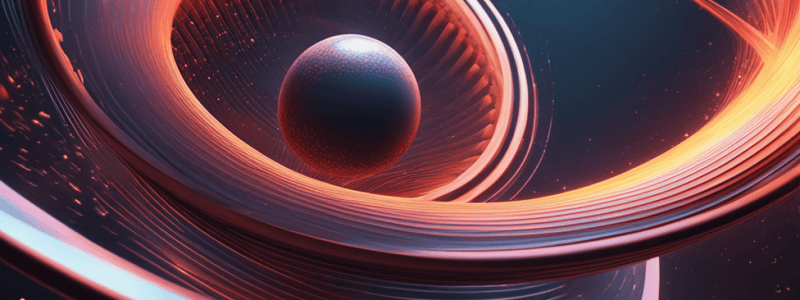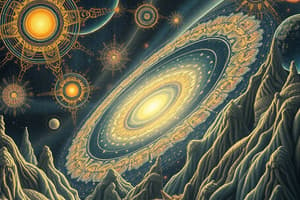Podcast
Questions and Answers
¿Albert Einstein presentó su teoría de la relatividad general en 1915?
¿Albert Einstein presentó su teoría de la relatividad general en 1915?
Verdadero (A)
En física clásica, el tiempo y la distancia se consideraban absolutos y las velocidades bajas no afectaban su velocidad.
En física clásica, el tiempo y la distancia se consideraban absolutos y las velocidades bajas no afectaban su velocidad.
Falso (B)
¿La velocidad de la luz es constante en todos los marcos de referencia?
¿La velocidad de la luz es constante en todos los marcos de referencia?
Verdadero (A)
¿El segundo postulado de la teoría establece que la velocidad de la luz depende del estado de movimiento de la fuente o del observador?
¿El segundo postulado de la teoría establece que la velocidad de la luz depende del estado de movimiento de la fuente o del observador?
¿Los objetos masivos provocan una curvatura del espacio-tiempo, lo que da como resultado la fuerza de gravedad observada?
¿Los objetos masivos provocan una curvatura del espacio-tiempo, lo que da como resultado la fuerza de gravedad observada?
Los objetos a altas velocidades experimentan que el tiempo pasa más rápido en comparación con los objetos en reposo.
Los objetos a altas velocidades experimentan que el tiempo pasa más rápido en comparación con los objetos en reposo.
Las partículas sin masa, como los fotones, experimentan el tiempo de la misma manera que los objetos masivos.
Las partículas sin masa, como los fotones, experimentan el tiempo de la misma manera que los objetos masivos.
El bosón de Higgs es la única partícula capaz de crear tiempo.
El bosón de Higgs es la única partícula capaz de crear tiempo.
El tiempo no existe sin masa; un universo compuesto únicamente de fotones tendría tiempo y espacio.
El tiempo no existe sin masa; un universo compuesto únicamente de fotones tendría tiempo y espacio.
Si uno superara la velocidad de la luz, el tiempo transcurriría en un sentido positivo.
Si uno superara la velocidad de la luz, el tiempo transcurriría en un sentido positivo.
Flashcards are hidden until you start studying
Study Notes
- Albert Einstein presented his theory of relativity general in 1915, challenging the long-held belief that time and space are absolute and independent.
- In classical physics, time and distance were considered absolute and low velocities did not affect their velocity.
- Einstein discovered that time and space are not absolute nor independent, as shown by the behavior of light. Light is made up of electromagnetic fields that propagate through space at a constant velocity of approximately 299,792 kilometers per second.
- James Clerk Maxwell's laws of electromagnetism stated that any wave in the electromagnetic field must move at the speed of light, leading to a contradiction when applied to moving observers.
- The concept of frames of reference and the addition of velocities was introduced to explain the apparent discrepancy.
- The theory of relativity introduces the idea that time and space are interconnected and that the velocity of light is constant in all frames of reference.
- The second postulate of the theory states that the velocity of light is independent of the state of motion of the source or observer.
- This leads to the observation that time passes more slowly for an observer in motion relative to an observer at rest.
- The theory also explains that massive objects cause a curvature of space-time, which results in the observed force of gravity.
- The curvature of space-time also affects the passage of time, as objects experience time differently depending on their position and velocity.
- The theory has been confirmed by numerous experiments, including the discrepancies observed in atomic clocks and the aberration of the light emitted by stars observed from different locations.
- The GPS system relies on the consideration of relativity to ensure accurate calculations.
- As an object approaches the speed of light, time dilation becomes more significant, with objects at high velocities experiencing time passing slower compared to objects at rest.
- The passage of time comes to a standstill for an object traveling at the speed of light, and the concepts of past, present, and future do not apply.
- Particles without mass, such as photons, do not experience time in the same way as massive objects, as they do not deform the fabric of space-time.- The concept of experiencing all phenomena in the universe at once raises the idea that eternity exists.
- The reality of our universe is not as it seems; space-time has connections, like a vast ocean with folds, wrinkles, and perturbations where masses distort the fabric, creating the illusion of time.
- Time does not exist without mass; a universe composed only of photons would not have time, only space.
- Particles without mass are necessary for the interaction with massive particles, and the emergence of time hinges on the boson of Higgs, which interacted with itself to create its field and mass.
- The Higgs boson is the only particle capable of creating time; it emerged from the Higgs field.
- Every object in motion carries its internal clock, with its ticking deriving from its interaction with the Higgs field.
- Louis Brough Lee, in her 1924 doctoral thesis, concluded that an object in motion carries its unique time due to its mass and velocity.
- If one were to surpass the speed of light, time would transpire in an imaginary sense with a negative number, which goes beyond the equations of relativity, signifying a departure from the universe in a different dimension.
- The theory of relativity opened a door to another dimension of existence, and humanity understood that time is not absolute but a dimension that depends on velocity and gravity.
- We are trapped as ants on a four-dimensional space-time web, with time neither stopping nor waiting for anyone.
Studying That Suits You
Use AI to generate personalized quizzes and flashcards to suit your learning preferences.




